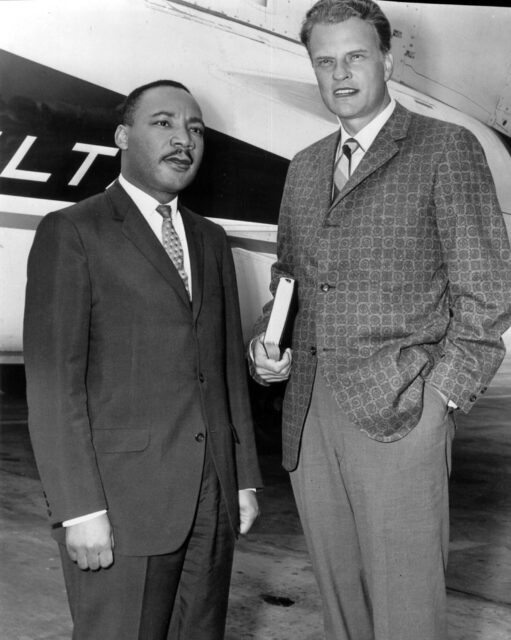(RNS) — White people regularly dilute the words of the Rev. Martin Luther King Jr. to be more palatable. No one is more prone to this temptation than we white Christians who want to think of ourselves as the kind of well-meaning people who love King.
Doubt me? Check the church bulletin this MLK weekend and see what makes the cut. “I have a dream”? Check. “Beloved community”? Check.
“In the midst of blatant injustices inflicted upon the Negro, I have watched white churchmen stand on the sideline and mouth pious irrelevancies and sanctimonious trivialities”? Probably not.
As we mark King’s birthday on Jan. 15 and look ahead to the national celebration on Monday (Jan. 17), we need to get beyond the shallow and partial recollections of the safe King highlight reel.
RELATED: King’s last full year of life: Protest, praise, ire, incarceration
I would wager that most white Americans know little of the actual context and content of that great defining speech King delivered Aug. 28, 1963, on the steps of the Lincoln Memorial. The four words comprising its title have conveniently come to stand in for the whole.
If memory serves, prior to studying King’s writing and speeches in graduate school, my own knowledge — imparted from my Southern Baptist church and the public school system in Jackson, Mississippi — was tightly circumscribed. I knew King was a leading civil rights leader and that the celebration of his birthday was combined in Mississippi with the official state holiday celebrating Robert E. Lee’s birthday (as it continues to be today in both Mississippi and Alabama). I knew that he had spoken eloquently of his dream of Black and white children joining hands as equals.
But I did not know, for example, that the Rev. Billy Graham rejected that vision of racial harmony King imagined might flower among my generation — musing that something that audacious would only be accomplished in heaven, never on earth. And I remained blissfully ignorant of the 1,052 words King delivered before the word “dream” ever crossed his lips, the searing indictment of racial injustice and white indifference in America that formed the canvas on which his vision was painted.
Here is a sampling:
- But one hundred years (after the Emancipation Proclamation), the Negro still is not free. One hundred years later, the life of the Negro is still sadly crippled by the manacles of segregation and the chains of discrimination. … And so we’ve come here today to dramatize a shameful condition.
- We have also come to this hallowed spot to remind America of the fierce urgency of Now. … And those who hope that the Negro needed to blow off steam and will now be content will have a rude awakening if the nation returns to business as usual. And there will be neither rest nor tranquility in America until the Negro is granted his citizenship rights.
- There are those who are asking the devotees of civil rights, “When will you be satisfied?” We can never be satisfied as long as the Negro is the victim of the unspeakable horrors of police brutality. … We cannot be satisfied as long as the negro’s basic mobility is from a smaller ghetto to a larger one. … No, no, we are not satisfied, and we will not be satisfied until “justice rolls down like waters, and righteousness like a mighty stream.”
It is only after laying out the awful racial injustices and prejudice in the country that King pivots to the line I was taught: “So even though we face the difficulties of today and tomorrow, I still have a dream.”
Of all of King’s speeches and writings, the one that has had the most transformative power for me is his masterful “Letter from Birmingham Jail,” which ranks with Lincoln’s Second Inaugural Address in the canon documenting America’s ongoing struggle to wrench its soul from the greedy clutches of white supremacy.
From a solitary confinement prison cell in Birmingham, King wrote a response to an open letter published in a Birmingham newspaper by eight prominent local Christian and Jewish leaders who criticized him as an outside agitator and his civil rights work as “unwise and untimely.” It’s notable that these religious leaders were widely considered to be the respectable “moderates” on racial issues, not the most prejudiced elements of the city.
King’s dismay and exasperation at self-satisfied white Christians holds up a mirror that is still painfully relevant today. The following is a lengthy excerpt (the full letter can be read here), but I invite you to read it slowly and let each paragraph sink in this holiday weekend:
When I was suddenly catapulted into the leadership of the bus protest in Montgomery, Alabama, a few years ago, I felt we would be supported by the white church. I felt that the white ministers, priests and rabbis of the South would be among our strongest allies. Instead, some have been outright opponents, refusing to understand the freedom movement and misrepresenting its leaders; all too many others have been more cautious than courageous and have remained silent behind the anesthetizing security of stained glass windows. …
I have heard numerous southern religious leaders admonish their worshipers to comply with a desegregation decision because it is the law, but I have longed to hear white ministers declare: “Follow this decree because integration is morally right and because the Negro is your brother.” In the midst of blatant injustices inflicted upon the Negro, I have watched white churchmen stand on the sideline and mouth pious irrelevancies and sanctimonious trivialities. In the midst of a mighty struggle to rid our nation of racial and economic injustice, I have heard many ministers say: “Those are social issues, with which the gospel has no real concern.” And I have watched many churches commit themselves to a completely other worldly religion which makes a strange, un-Biblical distinction between body and soul, between the sacred and the secular.
I have traveled the length and breadth of Alabama, Mississippi and all the other southern states. On sweltering summer days and crisp autumn mornings I have looked at the South’s beautiful churches with their lofty spires pointing heavenward. I have beheld the impressive outlines of her massive religious education buildings. Over and over I have found myself asking: “What kind of people worship here? Who is their God? Where were their voices when the lips of Governor Barnett dripped with words of interposition and nullification? Where were they when Governor Wallace gave a clarion call for defiance and hatred? Where were their voices of support when bruised and weary Negro men and women decided to rise from the dark dungeons of complacency to the bright hills of creative protest?”. …
There was a time when the church was very powerful–in the time when the early Christians rejoiced at being deemed worthy to suffer for what they believed. In those days the church was not merely a thermometer that recorded the ideas and principles of popular opinion; it was a thermostat that transformed the mores of society. Whenever the early Christians entered a town, the people in power became disturbed and immediately sought to convict the Christians for being “disturbers of the peace” and “outside agitators.”‘ But the Christians pressed on, in the conviction that they were “a colony of heaven,” called to obey God rather than man. Small in number, they were big in commitment. They were too God-intoxicated to be “astronomically intimidated.” By their effort and example they brought an end to such ancient evils as infanticide and gladiatorial contests. Things are different now. So often the contemporary church is a weak, ineffectual voice with an uncertain sound. So often it is an archdefender of the status quo. Far from being disturbed by the presence of the church, the power structure of the average community is consoled by the church’s silent–and often even vocal–sanction of things as they are.
But the judgment of God is upon the church as never before. If today’s church does not recapture the sacrificial spirit of the early church, it will lose its authenticity, forfeit the loyalty of millions, and be dismissed as an irrelevant social club with no meaning for the twentieth century. Every day I meet young people whose disappointment with the church has turned into outright disgust.
I could write a page full of thoughts from each of these piercing paragraphs, but permit me to offer some brief meditations on three of King’s observations.
I have returned, again and again, to King’s description of white Christians remaining “silent behind the anesthetizing security of stained glass windows.” In hindsight, it is clear that a central function of the theology taught in my Southern Baptist church was to heighten my sense of personal sin while dulling my moral sensibilities about the systemic racism swirling just outside the church windows. This was, I now understand, an unacknowledged prerequisite for any theology that could survive our self-perceptions and the status quo of our lives.
King’s dismay about what could possibly be being preached and taught in the South’s (but not only the South’s) beautiful churches and their “massive religious education buildings” is poignant. His question, “Where were their voices when the lips of Governor Barnett dripped with words of interposition and nullification?” is framed as a rhetorical one. But it has a concrete historical answer.
As I documented in my book “White Too Long,” the voices of First Baptist Church in Jackson, the most prominent church in the state, were united in support behind the segregationist campaign of Ross Barnett, who served as a deacon and popular teacher of the large men’s Sunday school program. On the evening before his gubernatorial inauguration in 1960, the Rev. Douglas Hudgins conducted a Christian consecration service for Barnett, presenting him with an ornate pulpit Bible in a special ceremony in the sanctuary. The 14,000-member First Baptist Church in Dallas has played a similar role blessing Donald Trump’s racism, Islamophobia and lies.
Finally, King’s warning that the church, particularly the white church, is in danger of losing its authenticity and in danger of being perceived as “an irrelevant social club” by younger Americans is bearing itself out. Over the last two decades, the most distinctive dynamics in the American religious landscape have been the decline of self-identified white Christians (currently only 44% of the population, down from 54% in 2008), coupled with the rise of the religiously unaffiliated.
In King’s day, the proportion of Americans who claimed no religious affiliation was in the single digits. Today, about 1 in 4 Americans — and about 4 in 10 younger Americans under the age of 30 — are religiously unaffiliated. The ranks of the unaffiliated are being bolstered disproportionately by the steady exodus of younger Americans from white Christian churches. The median age of white evangelical Protestants has ticked up to 57, compared with a median age of 44 in the general population.
RELATED: Black faith leaders’ proud legacy on civil rights should include LGBTQ rights
Nearly six decades on, given how relevant — and therefore threatening — King’s words remain, it is perhaps not surprising that the Republican-controlled Texas Senate voted this past summer to remove both “I Have a Dream” and “Letter from Birmingham Jail” from required reading lists in Texas schools. The bill was supported and prominently defended by Lt. Gov. Dan Patrick, who is white and whose official website includes the page “Stand for Christ,” where he describes himself as “Christian first, Conservative second and Republican third.”
Too often, and too unashamedly, white Christians and white Christian churches continue to function as “archdefender(s) of the status quo.”
Particularly for we white Christians who think of ourselves as the kind of people who honor King and imagine ourselves supporters of his dream, meditating on King’s hard words about white Christianity is an authentic way to celebrate his birth and life.

Robert P. Jones. Photo courtesy of PRRI
(Robert P. Jones is the CEO and founder of the Public Religion Research Institute and the author of “White Too Long: The Legacy of White Supremacy in American Christianity.” This article was originally published on Jones’ Substack #WhiteTooLong. Read more at robertpjones.substack.com. The views expressed in this commentary do not necessarily reflect those of Religion News Service.)





